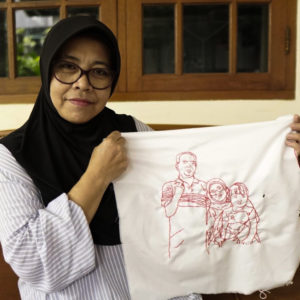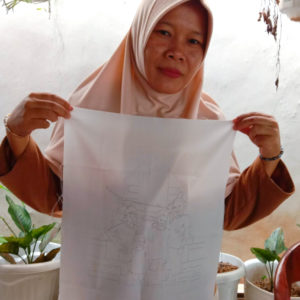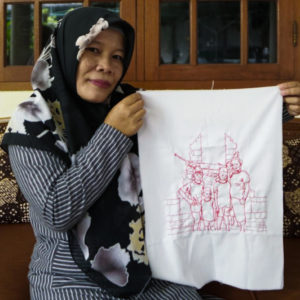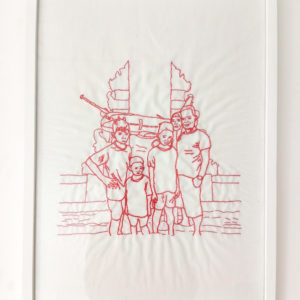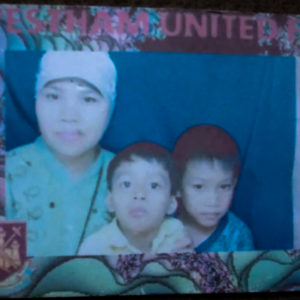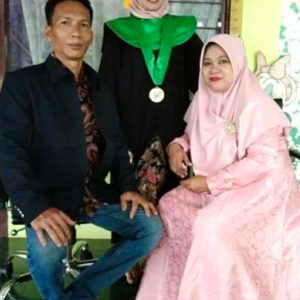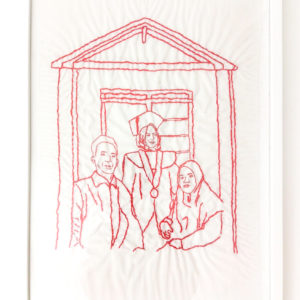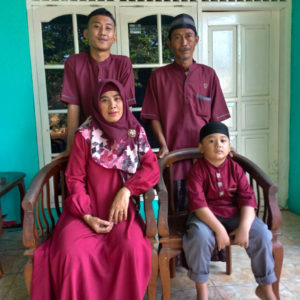Archiving Memories
ARTISTS: Meita Meilita with Ibu-ibu Dasa Wisma RT 04 in Jagakarsa
How do we nurture an inclusive space for collaborative work and co-authorship?
Archiving Memories is a project that is carried out in collaboration with community. In this iteration, I approached members of a local women’s organization in RT 04 Jagakarsa, the ward in South Jakarta to which Gudskul belongs. I wish to work with women who live near my studio in Gudskul, for us to learn from each other’s personal experiences and various backgrounds. We gathered regularly to share stories about how we see ourselves, our family histories, our relationships, our neighbourhood, and our strategies for managing daily life. Based on our conversations, I offer embroidery as an artistic approach to process one’s personal archive as events and stories that shape our present context.
Collaborative and participatory art practices must consider issues of ethics, aesthetics, and politics. How do I as an outsider offer artmaking as a collaborative activity? I began by visiting them to get to know one another as women and mothers. What are the issues that we all face? How can our collaborative activities allow us to reflect these shared experiences? How can we build a lasting and reciprocal relationship? I seek to build relationships beyond artmaking, but into the realm of everyday life. Recently, Ibu-Ibu visited me at home to meet my newborn. For me, art serves as a start to build new relationships.
Archive and memory: two words that are interconnected, two words that refer to the desire to remember. However, what we remember is not forever intact. Memory fades with time. Memory is a history without materiality, while the materiality of an archive can serve as a conductor to trace memories. Human memory is so unique that the “conductor” is not limited to physical objects. A certain aroma, texture, or situation can also trigger our memories. Every individual has memories of the past. Through memory, we can relive our awareness of past experiences.
I feel a certain intimacy when embroidering that allows me to retrace who I am. For me, embroidery is a way to make my emotions palpable, a medium to train my emotions and thoughts, and a way to express courage in voicing my personal experiences and contextualizing them within the social sphere. By practicing embroidery in community, I wish to learn from the personal experiences of my women collaborators who come from different backgrounds.
In this project, I approached the members of a local association of mothers, Dawa Wisma PKK (Family Welfare Empowerment), in RT 04, Jagakarsa, Gudskul’s neighbourhood association. Of the 14 members, 11 mothers agreed to take part. They are: Ibu Dadah, Ibu Dahlia, Ibu Diah, Ibu Dwi Restu, Ibu Mariah, Ibu Marini, Ibu Munah, Ibu Nisa, Ibu Suyanah, Ibu Qodar, and Ibu Yuli. (Note: Ibu is an honorific that translates to Madam or Mrs. Ibu-ibu is the plural version and in this case refers to this group of women). We met every Monday on the terrace of Ibu Dadah, as per the group’s regular schedule.
As an offering, I introduced them to my practice and approach to embroidery. Materially, embroidery with fabric, needle, and thread is commonplace in the daily life of mothers. I chose embroidery not only as a medium to memorialize and preserve memories, but to make space for storytelling. We embroider together using the back-stitch technique as a tool for the tracing of memories, each stitch forming a visual representation of our memories. The simple cognitive exercise of embroidering can delay the process of memory loss in old age, and consequently the practice has become a common leisure activity for elderly women.
At each meeting, we exchanged stories from our day-to-day life. I became aware of the activities of each mother. In addition to managing their households and carrying out their roles in the organization, some of them also do school pickups and dropoffs, garden, teach the Qu’ran, and cater. I became familiar with the personal characters of each of the mothers and we established a certain closeness. At first, as an outsider, I was cautious not to overstay my welcome or overstep anyone’s boundaries, but the openness of the mothers made our relationship even more intimate that I was even invited to participate in their activities and field trips, as well as provided with the group uniform.
Ibu-ibu chose family photos as source images for the embroidery, specifically photos that represent memorable stories that they had not shared before. One mother chose a photo of a family vacation because she remembered seeing her children being excited about getting on a plane for the first time. Another mother chose a photo of a graduation ceremony at home during the pandemic because she felt happy and proud of her child’s journey. Another mother chose to embroider a photo of her firstborn’s wedding, which was not witnessed by her late husband, as proof of a promise that has been kept. These photos are personal archives, a certain story or moment from the past that formed a context for their lives today. I helped each Ibu in collaging and forming a composition for their final source image. The sketch is then printed, enlarged, and transferred to the fabric using carbon paper. Each Ibu embroidered their picture using red thread.
The project “Archiving Memories” uses the principle of participatory learning and action as a process where a group of people help each other to learn from their experiences. The process was based on a two-way learning between myself and the Ibu-ibus involved in the project. The Ibu-ibu are artists who participate in the creation process, as much as I do.
The result of the “Archive Memories” project is a piece of embroidery from each Ibu, framed and ready to be exhibited. Each Ibu’s embroidery was exhibited in their own house, in the living room or family room. Pictures from the personal archive of each mother’s family were returned to their original homes. The embroidery artworks serve not only as home decoration, but also as a reminder of their stories.
To bring their stories to a wider public, the works of the Ibu-ibu are also exhibited at Gudskul’s gallery. As an art space located in the neighbourhood where the Ibu-ibu live, it should also be a space for the surrounding residents. Gudskul can be a meeting point between art practice and citizens’ expressions, bringing together the personal stories of Ibu-ibu PKK Dasa Wisma RT 04 with stories from other parents and women. Personal stories are always intertwined with various aspects of life: with the social, cultural, political, economic and environmental. As such, the act of embroidery functions as an elicitation technique that can start a dialogue.
Arsip dan Memori. Dua kata yang saling berkaitan satu sama lain. Dua kata yang bermakna sebagai penyimpan ingatan. Namun ingatan di dalam memori manusia tak selamanya utuh. Ingatan dapat terus membekas di kepala kita, namun sewaktu-waktu juga dapat menjadi samar. Ingatan adalah sejarah yang tak termaterialisasikan. Sementara arsip sebagai material dapat menjadi konduktor untuk menelusuri ingatan, melalui teks, visual maupun audio visual. Begitu khasnya ingatan manusia, konduktor tak hanya terbatas pada objek fisik. Aroma yang tercium, tekstur yang diraba, dan situasi yang mengesankan dapat juga menjadi pemantik ingatan. Setiap personal memiliki ingatan yang menyimpan masa lalu. Melalui ingatan, kesadaran akan pengalaman masa lalu hidup kembali.
Saya memiliki hubungan yang intim dengan penciptaan karya melalui teknik sulam. Keintiman yang saya rasakan saat menyulam membuat saya menelusuri kembali siapa saya. Berkarya melalui seni sulam bagi saya adalah sebagai bentuk manifestasi perasaan, sebagai medium melatih emosi dan pikiran, sebagai cara menunjukan keberanian dalam menyuarakan persoalan personal yang berkelindan dalam lingkup sosial. Melalui proses berkarya tersebut, saya ingin saling belajar dari pengalaman personal perempuan-perempuan lain dengan beragam latar belakang kehidupan.
Proyek seni “Mengarsipkan Ingatan” ini bekerja bersama Ibu-Ibu Pemberdayaan Kesejahteraan Keluarga (PKK) Dasa Wisma RT 04, Jagakarsa, dari lingkungan Gudskul Ekosistem, sebuah ruang kesenian di Jakarta. Dari 14 orang ibu yang tergabung dalam PKK Dasa Wisma RT 04, 11 orang ibu bersedia mengikuti kegiatan ini, yang terdiri dari Ibu Dadah, Ibu Dahlia, Ibu Diah, Ibu Dwi Restu, Ibu Mariah, Ibu Marini, Ibu Munah, Ibu Nisa, Ibu Suyanah, Ibu Qodar, dan Ibu Yuli. Kami menyepakati hari pertemuan dilakukan setiap hari Senin di teras rumah ibu Dadah (ibu RT 04), yang memang merupakan jadwal pertemuan mingguan ibu-ibu PKK Dasa Wisma RT 04.
Saya memperkenalkan dan menawarkan praktik keberkaryaan saya yaitu seni sulam kepada para ibu-ibu. Secara material, seni sulam sebenarnya dekat dengan keseharian ibu-ibu; kain, jarum dan benang. Kami menyulam bersama dengan teknik tusuk balik. Seni sulam dipilih bukan hanya sebagai media untuk mengabadikan dan menyimpan ingatan, namun sebagai ruang ingatan untuk bercerita. Teknik tusuk balik digunakan sebagai cara untuk menelusuri ingatan, melalui proses menyulam helai demi helai benang dengan tangan hingga membentuk visual sebagai ingatan. Latihan kognitif sederhana dalam menyulam dapat menunda proses otak kehilangan memori menjelang usia tua, dengan itu menyulam identik dengan kegiatan mengisi waktu luang yang dilakukan oleh perempuan lansia.
Setiap pertemuan kami saling bertukar cerita keseharian. Saya jadi mengetahui kegiatan masing-masing tiap ibu, selain sebagai ibu rumah tangga dan aktif menjalankan perannya dalam organisasiorganisasai, ada juga yang sehari-harinya mengantar jemput anak sekolah, mengurus kebun, mengajar ngaji, dan menerima pesanan masakan. Dengan itu saya jadi mengetahui karakter pribadi tiap ibu-ibu, dari sanalah kedekatan saya bersama mereka terjalin. Awalnya sebagai orang luar, saya merasa sungkan, namun keterbukaan para ibu-ibu tersebut semakin membuat hubungan kami semakin intim, bahkan saya diajak untuk mengikuti kegiatan mereka, dibuatkan seragam kelompok hingga diundang untuk ikut serta wisata bersama.
Kami memilih foto-foto keluarga sebagai visual yang akan disulam. Foto-foto keluarga dipilih berdasarkan dari cerita yang berkesan secara personal bagi masing-masing ibu, yang sebelumnya tidak pernah terungkapkan. Seperti foto-foto saat liburan bersama keluarga yang mana sebagai ibu melihat anak-anaknya sangat senang memiliki pengalaman pertama kali naik pesawat, foto upacara wisuda di rumah saat masa pandemi yang mana sebagai ibu merasa bahagia sekaligus terharu karena bangga atas perjuangan sang anak, dan foto pernikahan anak pertama yang tidak dapat disaksikan oleh mendiang suami menjadi sebuah pembuktian ibu akan janji yang telah ditepati. Foto-foto keluarga tersebut merupakan arsip personal, sebuah cerita dan peristiwa masa lalu yang membentuk konteks kehidupan yang terjadi hari ini. Saya membantu tiap ibu untuk mengkomposisi dan mengkombinasi foto menjadi sketsa yang akan disulam. Kemudian sketsa dicetak, diperbesar dan dipindahkan ke kain menggunakan kertas karbon. Setelah itu masing-masing ibu menyulam gambar dengan menggunakan benang merah.
Proyek seni “Mengarsipkan Ingatan” menggunakan metode partisipatoris dengan prinsip participatory learning and action sebagai proses dimana sekelompok masyarakat saling membantu satu sama lain untuk belajar dari pengalaman mereka. Proses itu didasari oleh adanya pembelajaran secara dua arah, antara saya dengan ibu-ibu yang terlibat saat kegiatan proyek ini berlangsung. Ibu-ibu PKK diposisikan sebagai subjek yang turut serta dalam proses penciptaan, dimana saya menempatkan diri setara dengan ibu-ibu sebagai seniman.
Hasil dari proyek “Mengarsipkan Ingatan” ini berupa karya seni sulam dari masing-masing ibu yang telah dibingkai dan siap dipamerkan. Karya seni sulam tiap ibu dipamerkan di rumah masing-masing ibu, di ruang tamu dan ruang keluarga. Gambar dari arsip personal mengenai keluarga tiap ibu dikembalikan pada tempat muasalnya yaitu rumah. Karya seni sulam tersebut tidak hanya sebagai dekorasi rumah, namun juga sebagai pengingat akan cerita-cerita mereka.
Untuk membawa cerita-cerita personal mereka ke dialog yang lebih luas, maka karya-karya para ibu tersebut juga dipamerkan di ruang terbuka publik yaitu di galeri Gudskul. Sebagai ruang kesenian yang berada di lingkungan tempat tinggal para ibu PKK Dasa Wisma RT 04, sudah seharusnya juga menjadi ruang bagi warga sekitarnya. Gudskul dapat menjadi titik temu antara praktik kesenian dengan ekspresi warga, mempertemukan cerita personal ibu-ibu PKK Dasa Wisma RT 04 dengan berbagai banyak cerita dari ibu-ibu dan perempuan lainnya, bahwasanya kisah personal selalu berkelindan di antara berbagai aspek kehidupan; sosial, budaya, politik, ekonomi dan lingkungan. Sehingga fungsi karya seni sulam sebagai elisitasi ini dapat berdialog.
Ibu Dadah wanted to embroider a photo with her first granddaughter, because she has only had sons. Having a granddaughter in her life makes it a privilege, like she finally had a daughter. Since she had no photo of her with her husband and granddaughter at the same time, she asked me to combine these two photos into one image, which she would later embroider. Incidentally, she only has these two photos in digital form. Embroidering this picture becomes a way of archiving memories for him.
Ibu Nisa chose a memorable moment when her husband took her and their children to vacation in Bali by plane. Seeing the enthusiasm of her children to travel by plane for the first time made this holiday memorable for the family. I helped her by adding pictures of a plane and the airport in Bali. This is a way for Ibu Nisa to archive her memories.
Ibu Dwi wanted to capture some of the last moments she shared with her late husband. Initially, she wanted to draw the last photos of her and her family together, taken when returning home to Solo, Central Java for Eid. She asked me to combine these two photos so that her husband is looking at the camera.
However, in the middle of the process, she told us a very touching memory. She wished that her husband was present in the family photo of her first child’s wedding, rather than his brother who served in his stead.I wanted to realize her wish. I asked Ibu Dwi to provide an old photo of her husband when still in good health alongside her son’s wedding photo. I replaced the younger brother’s face in the actual wedding photo with the husband’s face so that it became one image to be embroidered into the family archive.
The image we created represents a mother’s love. For Ibu Yuli, the photo of her holding her child illustrates her struggles, sacrifices, and love for her children. Even though her children are now grown, she still feels like she is “holding” them—but in a different form.
Ibu Qodar’s ideas for her embroidery started with the impulse to archive moments from her day to day. Everyday, she helps her husband take care of their garden, where a starfruit tree grows. One day, Ibu Qodar saw a butterfly in the garden, larger than any other she had ever seen.
I tried to help Ibu Qodar in combining these ideas through the photos that she gave me. However, after the sketch was finished, Ibu Qodar then changed her idea after seeing other mothers embroidering family portraits. Ibu Qodar still keeps an old photobooth photo of her and her children. She wants to make a family photo that combines this photo with a photo of her current grown-up sons.
After the sketch was completed, Ibu Qodar felt that the family photo was incomplete without her husband. She resubmitted a photo of her and her husband to add to the sketch.
Ibu Munah’s work is about her daughter’s graduation, which was held at home due to the pandemic. Even though she was sad that her daughter did not have a proper graduation ceremony, Ibu Munah and her family were determined to proudly mark the occasion. They prepared costumes, took photos on their phone, and edited them to mimic traditional graduation photos. Ibu Munah and her family supported each other to realize a meaningful graduation ceremony even though it was only carried out at home. She felt the need to archive this moment through embroidery.
I helped Ibu Munah in making digital sketches according to her directions. She asked to use a photo of just her, her husband, and their daughter with a house in the background.
Ibu Suyanah, who is usually called Ibu Yanah, admitted that there were no family photos in her house. The only family photo that she and her family have is from her first daughter’s graduation in 2011. This photo is a source of pride for her as a mother who can support her daughter’s education until her studies are completed at one of the public universities in Jakarta. Because that moment meant so much to her, and because the photo was getting old, she decided to render this graduation photo in her embroidery work.
Ibu Dahlia chose a photo of her with her husband to embroider. According to her, her husband is a difficult person to photograph. This selfie was captured by accident, and makes it interesting to use for this project. She asked to combine the two photos so that they are both centered and facing the camera. Although she is embarrassed to say it, she hopes that this embroidery work can be a memory for her and her husband as her life partner.
Ibu Mariah has a son who is very difficult to photograph. One day while on vacation, the child unexpectedly wanted to be photographed with his family. It was the first photo of her, her husband, and her son. She asked me to help her sketch the picture for her embroidery.
After I finished the requested sketch, Ibu Mariah had another idea. She also wanted to embroider the adorable photo of her first grandson. She gave a photo with her grandson, but according to her, the photo lacks a sense of togetherness because everyone is far from each other.
I tried to combine the first and second photos, highlighting the presence of her grandson who is a valuable gift for the family.
Having three sons who are always difficult to photograph together means that Ibu Marini does not have any good family photos. Finally, at this year’s Eid, she was able to take a picture of everyone together: her, her three sons, and her husband. She chose this rare moment for her embroidery. This photo of her with her three sons and her husband exists only in digital form.
Ibu Diah’s children are the pearls in her life. She has one son and one daughter, both of whom she considers the most beautiful gifts in her life. They are good children who are obedient to their parents. In her embroidery work, she chose photos of her children as babies and as they are now.This record of their growth and development is a source of strength in her life.





